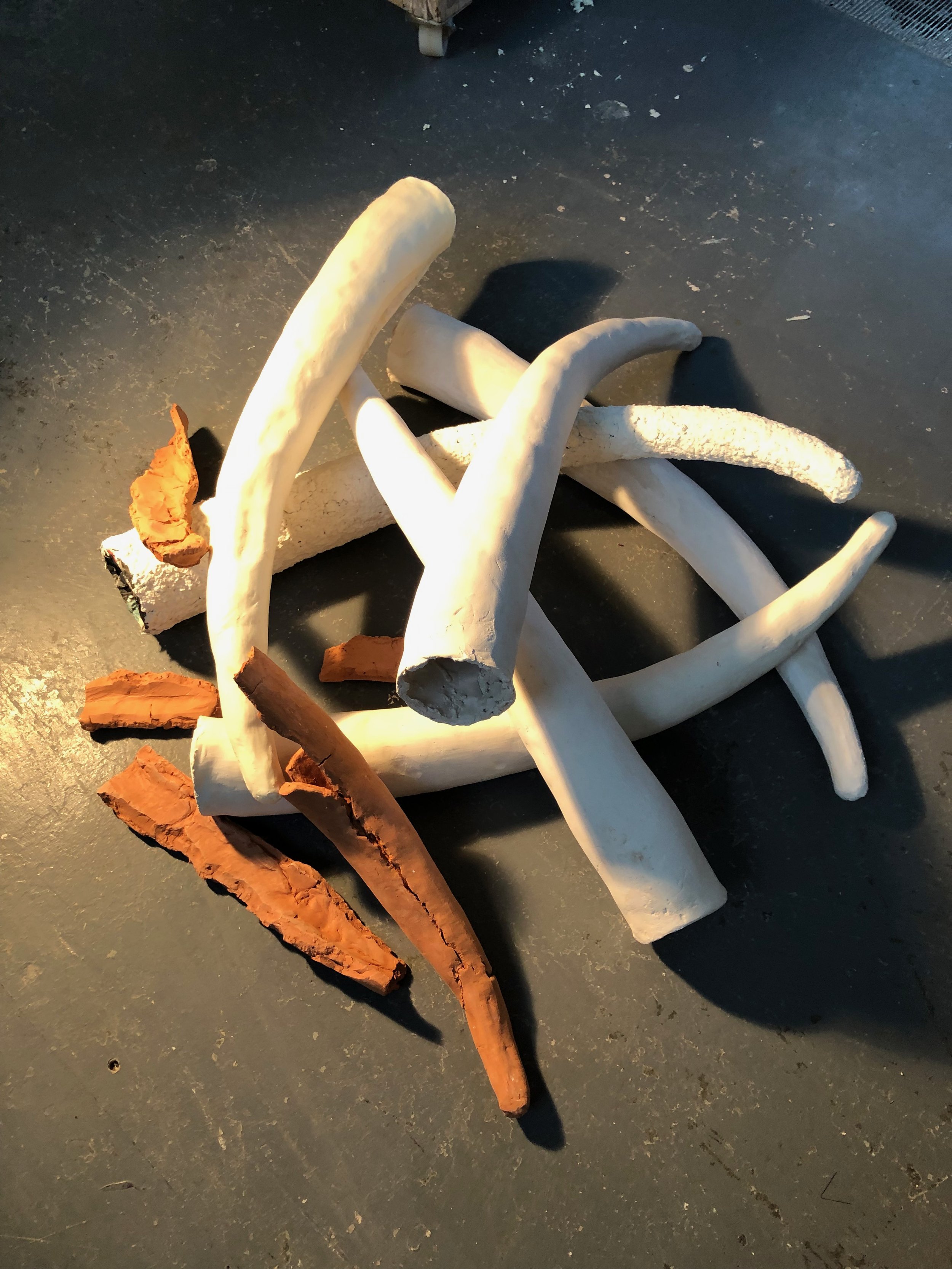Portfolio
Tusk size: 100 x 100 x 40 cm.
Materials: plaster, jesmonite, terracotta, papier-mâché.
Tusk WIP 2022
My current focus on endangered African elephants has led me to use the iconic form of a tusk to comment on the problems surrounding these animals. Human/wildlife conflict and poaching, as well as loss of habitat due to to climate change are areas of interest and I am exploring various materials for the construction of the tusks.These will be decorated in a variety of ways to highlight these issues eg barbed wire, bullet holes and blood. WIP..
Maquette for ‘Human Ivory’
I am collecting extracted teeth from my previous work colleagues to construct a tusk made out of human ivory. The photo shows a maquette of the likely design. The teeth will be sterilised and varnished before being glued . I estimate a minimum of 500 teeth will be required to create a tusk shape. The proposed use of teeth in this way is controversial and designed to stimulate discussion WIP
Foam tusk
I am also experimenting with many different materials including expanding industrial foam to create tusk forms.. The unpredictable finished form is often more interesting than a conventional tusk shape and mimics the decay of a rotting tusk or bone.

Tusk size: 70 x 15 x 15 cm. Materials: expanded industrial foam
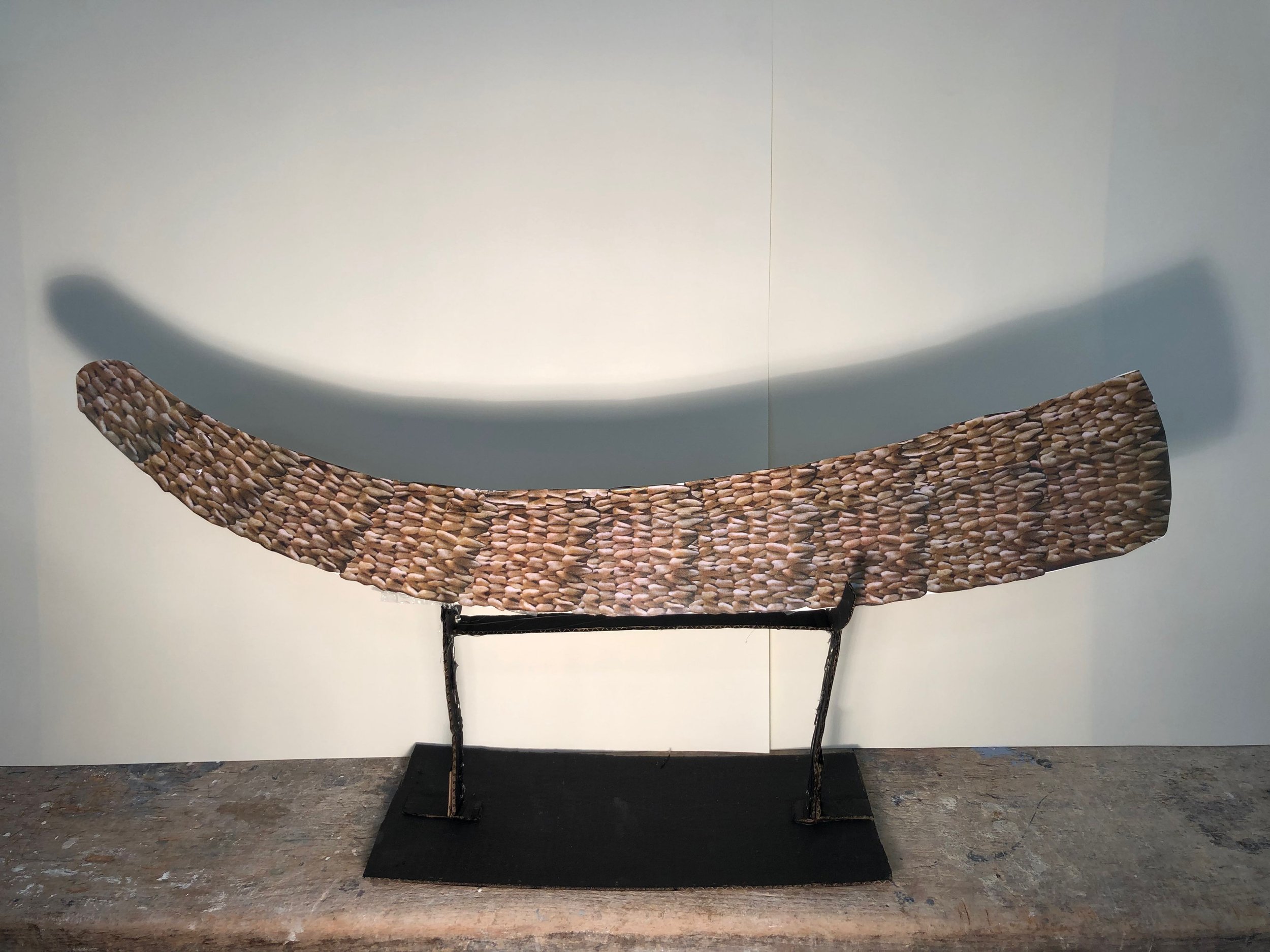
Tusk size: 70 x 15 x 15 cm. Materials: cardboard form with stock tooth images
Size: 45 x 45 x 45 cm.
Materials: glazed ceramic repaired with epoxy glue and gold paint
Fragile 2022
A ‘Kintsugi’ repaired ceramic globe is a metaphor for the destruction of the planet through climate changed environmental damage. Inspired by the COP26 climate conference in 2021, it was broken deliberately in a metal scrapyard as a performance piece and then repaired to ask the question- can we save the world and are the scars we have created as beautiful as the original? The missing pieces allude to the gaps in the ozone layer particularly over the Antarctic which have been lost and may never recover.
Fragile- image only
A visual of the moments before the ceramic globe was dropped. The workers in the scrapyard helped load the very fragile globe into the grabber crane claws and their reaction was as interesting because they considered the whole project ‘mad’ and couldn’t understand why I would want to destroy something I had so carefully constructed.
Fragile- the moment before the crash.
This image captures the moment before the globe hits the ground and symbolises the imminent loss that we face if action to reduce our greenhouse gas emissions and habitat destruction is not taken immediately. The metal scrapyard surrounding seemed the right place to film this concept as a place of destruction of cars and other metal objects. However the scrapyard is a leader in recycling metals and other materials and therefore keen to participate in the video shoot.
Fragile video- abridged version
A clip of the video accompanying the Fragile and Broken globes installation. The full version contains stock images of current environmental crises and animals under threat from climate change.
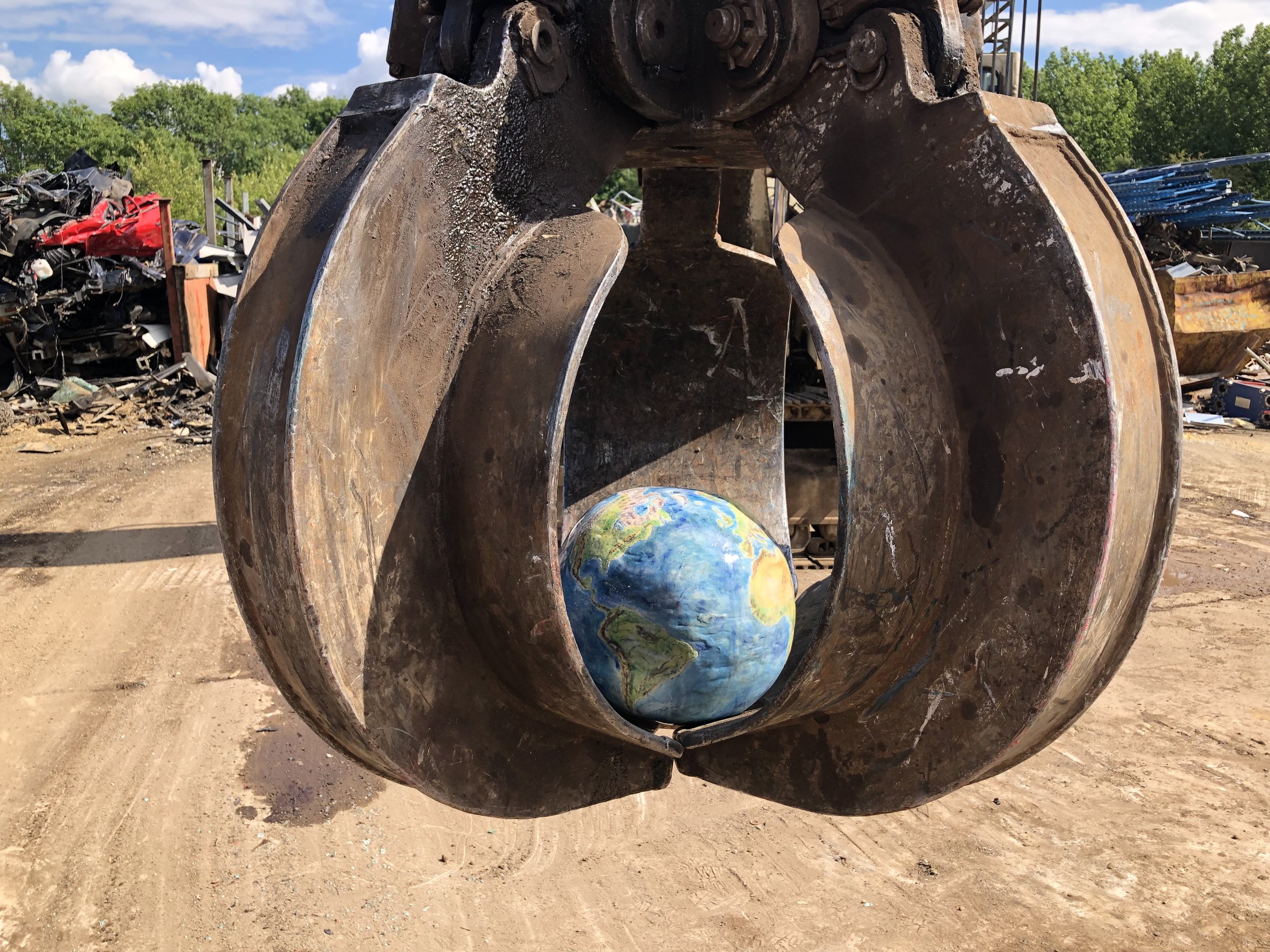
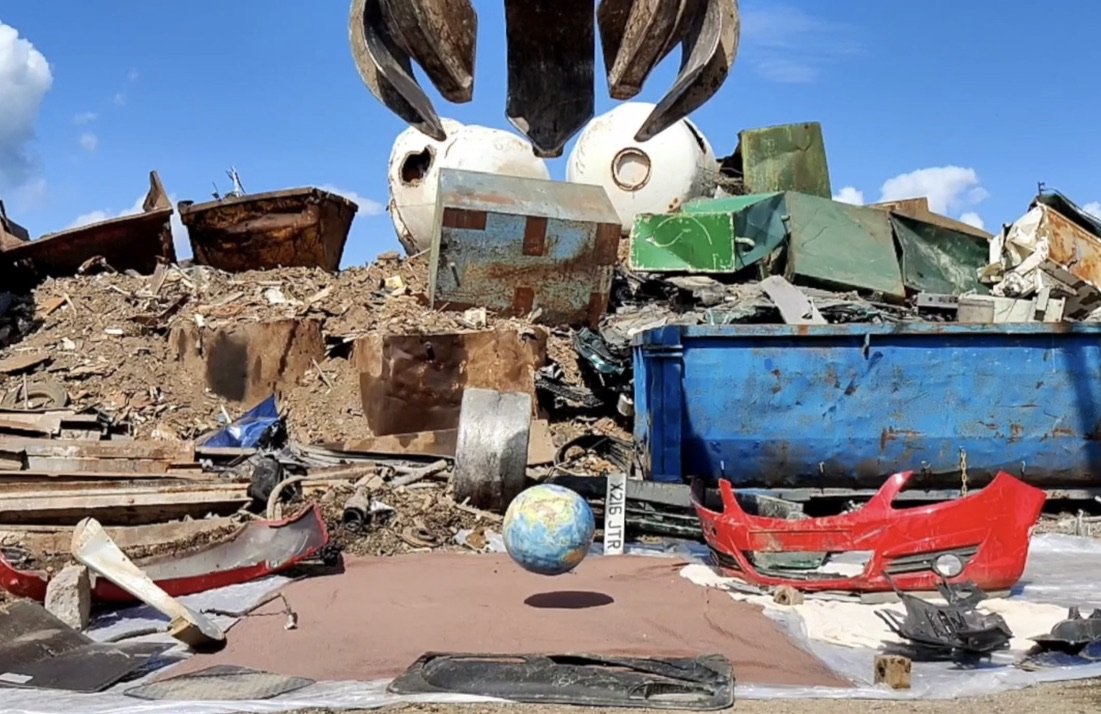
Size: 300 x 100 x 100 cm.
Materials: ceramic shards, silver wire, wooden frame
Broken 2022
This piece is ‘broken’. Initially it was a smaller ceramic globe made as a practice piece and spare to ‘Fragile’. It became a sculpture in its own right as a counterpoint to ‘Fragile’. I broke this globe in the same scrapyard but after seeing the Cornelia Parker exhibition at Tate Britain (thirty pieces of silver) I felt it would be a powerful way to express the reality of the situation by leaving the broken elements hanging from thin threads of silver jewellery wire suspended from a wood and mesh frame. Each shard of ceramic (64 in total) were suspended by multiple 3m lengths of wire and were carefully balanced 20cm above the ground. The hanging process took approx 7 hours to complete and they moved gently in the breeze , resembling the earth’s tectonic plates moving over each other.
Broken close up. A close up of the 64 broken pieces suspended 20cm above the ground.
Map size: 270 x 210 x 20 cm.
Materials: flip flops, wire frame, cable ties
The Flip Flop Cycle 2022
The map of Africa constructed out of donated flip flops on a steel mesh frame. The flip flops were collected by volunteers at Oxfam in Oxford and used to highlight the disposable society we are currently living in. These flip flops are the most washed up clothing items on beaches around the world and cause damage to marine life by releasing micro plastic particles into the oceans. However, the flip flops provide a valuable income for women, who collect them from the beaches in Kenya and sell them to cooperatives which reuse them for a variety of products. The colours are reflecting the different areas and climates in Africa and the flip flops are placed in a random pattern to reflect the constant changing diaspora.
Flip Flop Cycle
The installation on the wall of the art school car park. The graffiti was a collaboration with a sixth form student from the local school in Chelsea. We discussed the brief an he created the design for the final Diploma Show. The wall art reflects the views of the current school based generation which I felt was a necessary connection to complete the work.
Flip flop close up
A close up view of the flip flops held in position with cable ties. Cable ties are another source of damage to marine life if they enter the sea releasing micro plastics and the flip flop thongs act was a snare for marine life. Unfortunately the local council demanded the removal of the installation and the mural has been painted over. The flip flop map is now hanging in The Oxfam Superstore Oxford and is part of their ongoing sustainability promotion.
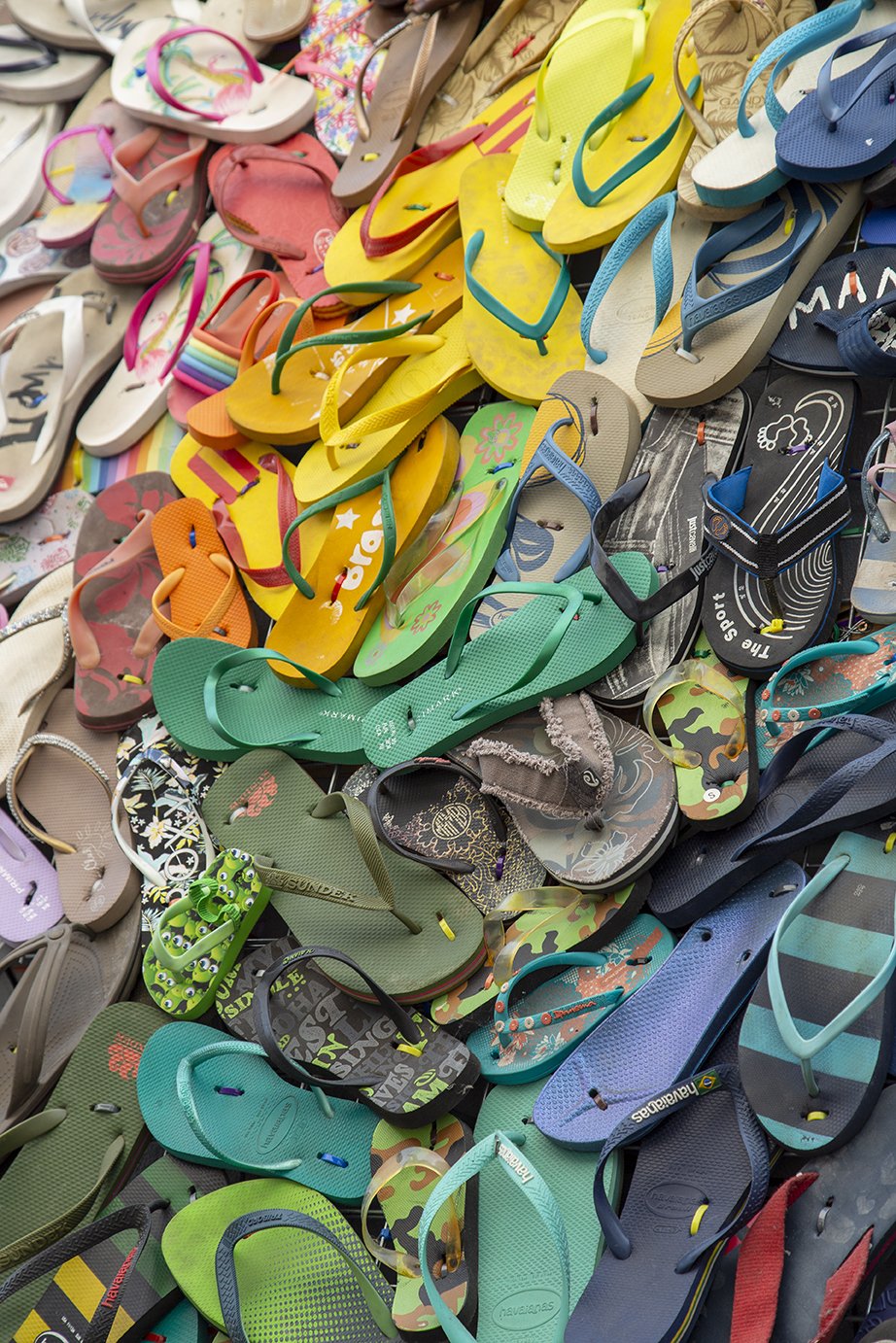

Overall size: 350 x 900 x 20 cm
Ostrich 2021
A concept piece based on the myth of an ostrich burying its head in the sand to avoid seeing danger. The head is based on the shape of an eye with a jet engine extension. Made from aluminium sheets and the ‘iris’ is simulating the fan blades of a jet engine. Copper tubing and a ceramic body (ostrich egg shaped) with ostrich feathers from a feather duster. The legs are modelled in ceramic based on human leg bones with ostrich feet. A comment on the human wildlife conflict currently in Africa and the role responsible tourism can play in defusing the situation by providing employment and stability for local communities. However there is a price to pay with aviation traffic and the increasing emissions from that sector. This is a dilemma which is increasingly being questioned but little action undertaken to mitigate the problem.
Ostrich close up
A close up view of the ceramic ostrich egg body, hip joint and human femur. Ostrich feathers from a feather duster were glued in position and the ‘bones’ held in place with steel pins and glue.
Size: 140 x 40 x 60 cm.
Materials: ceramic, copper tubing, feathers, aluminium sheet
Klein Meisje 2021
A two thirds life size study of our model during the first Diploma year. A powerful pose which inspired the use of the strong colour Klein Blue with a contrast of gold paint and gold leaf.
The detailed anatomical and artistic study of the life model was invaluable to reconnecting with my appreciation of human physical form. The use of colour and matt surface highlighted the muscle and skin structure
Size: 112 x 53 x 25 cm.
Materials: jesmonite, steel rods, acrylic paint, gold leaf
